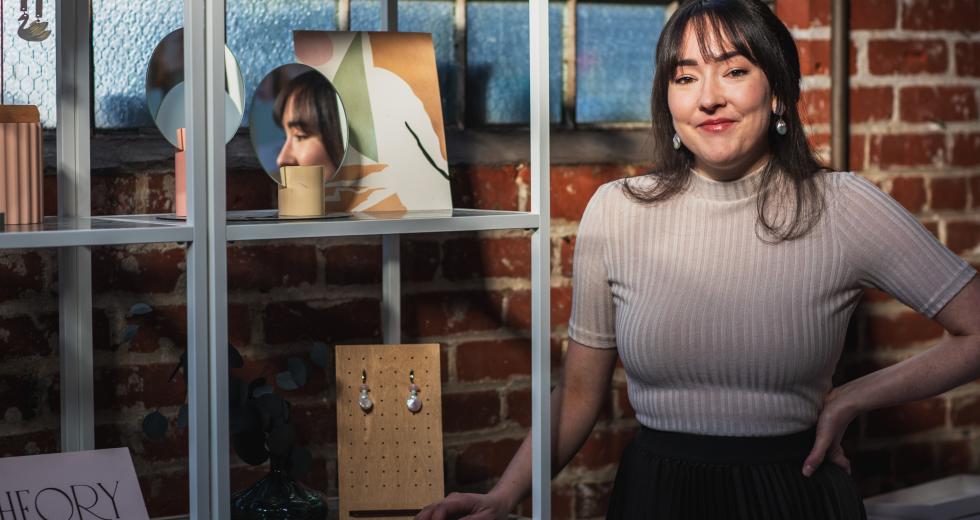Elyse Tolles is a one-woman show — a designer of artful jewelry and a former flutist. The feminine, ethereal pieces in her line of polymer clay-based jewelry, Elysian Theory, are inspired by classical mythology and the Elysian Fields, a heavenly place conceived by the ancient Greeks.
Tolles created the line in 2015 as “a creative outlet from her creative outlet,” which at the time was a high-pressure master’s program in music performance at Florida State University. As a classical musician, she nearly finished a doctorate, but pivoted to focus on her jewelry full time.
Growing up in Prescott, Arizona, Tolles was fascinated by gemology. She was immersed in the art of jewelry design through spending time at a custom-design fine jewelry store where her mother worked. She took her hands-on experience a step further with a high school sculpture class that involved mosaics and ceramics. Now, instead of working with traditional materials like ceramics or gems, she molds polymer clay into custom designs, mixing in various media such as freshwater pearls and beads she sculpts and polishes to a high shine.
The polymer clay craze has hit a fever pitch in recent years — its accessibility and affordability makes it a popular medium for burgeoning designers — but Tolles’ early adoption, craftsmanship, and distinct point of view have granted her recognition in the space. She currently has a collaboration with national clothing and lifestyle retailer Anthropologie, and previously partnered with Michaels Stores, which sells jewelry kits that include materials to make Tolles’ terrazzo-inspired earrings.
For Tolles, the joy of jewelry making is in creating unique, handmade pieces that don’t necessarily appear handmade. Creating each piece is a practice in balancing wabi-sabi, or the aesthetic acceptance of imperfection, with a high level of execution. Her designs involve a careful, extensive process: pigmenting the polymer material, mixing the colors, then sculpting, sanding, buffing, polishing and assembling each piece. “I’ve actually consciously tried to spend less time on things, but I just kind of can’t seem to get myself to do that,” she says.
Tolles made her way to California in 2017 for her husband’s career as a professional musician in the military. The pair moved from Davis to Sacramento in 2018 so she could “meet other young people that weren’t college students.” (After eight years of university study, she’d had her fill of college towns). Since settling into a studio space at the creative coworking collective Together Midtown, she feels more a part of the maker community and able to execute each facet of her business, from creating to marketing.
The creative inspiration behind Elysian Theory: It’s sort of like walking the line between soft and feminine and contemporary. Fusing contemporary design with those old-world aesthetics. A lot of my recent designs in particular have been really inspired by very, very old jewelry, like ancient Romans’ designs and Byzantine jewelry. And then jewelry that’s influenced by classical art and paintings from the 1800s and that whole aesthetic as well, which everyone is, of course, obsessed with now (with the popularity of “Bridgerton” on Netflix). I feel like my aesthetic has been like “Bridgerton” vibes long before it was a thing.
On finding her artistic medium: I’ve always been a crafty person and have dabbled in pretty much every different craft medium. Although I don’t like making that distinction between art and craft generally because I find that it’s usually kind of sexist. Art tends to be like the things that men do, and craft tends to be the things that women do. … I don’t know what it is specifically about working with clay, but I’ve always enjoyed it because it’s really tactile. The tactile experience is very appealing to me and not a whole lot of other art mediums have that. (Getting to wear the final product) is a plus. I mean, I’ve always liked fashion and accessories and all that stuff.
On needing a creative outlet from my creative outlet: I was really burned out in grad school and just needed to have a hobby again. It’s kind of pessimistic to look at it this way, but going to art school for anything kind of kills your ability to enjoy it. Just because you’re good at something doesn’t mean you should do it professionally and make it your career. Although recently, I’ve definitely started to miss (making music) more. I want to come back to it but in a different capacity, like take lessons on another instrument so I can just have fun with it.
Elyse Tolles launched her jewelry line in 2015.
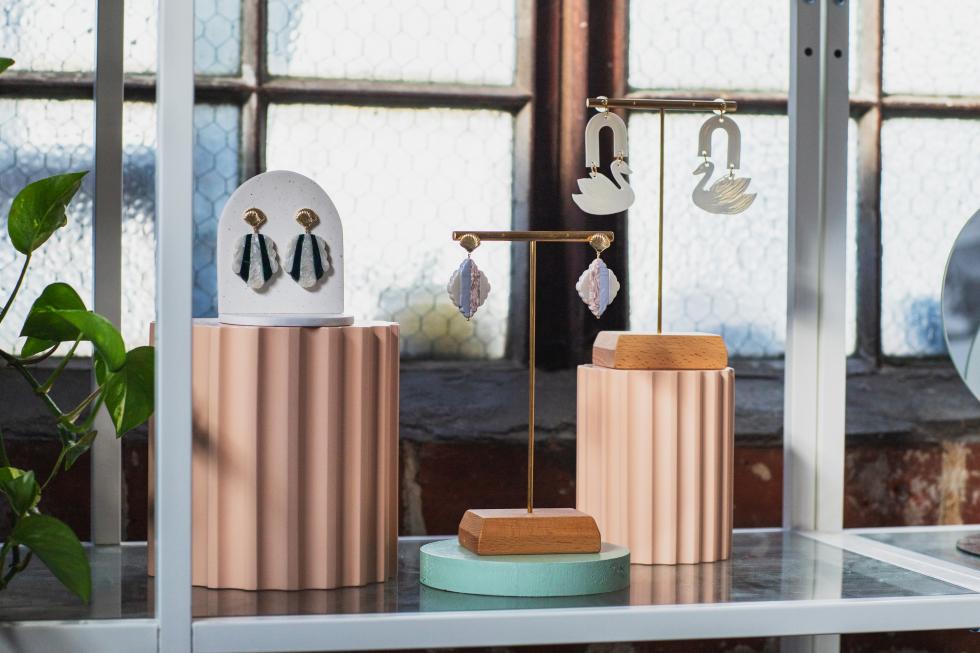
On becoming an Etsy success story, and breaking out on her own: I was on Etsy and using that as my primary selling platform through 2018. I got in at the right time, both with Etsy and also with being a maker who primarily uses polymer clay as a medium. I was being promoted by Etsy and being featured by them fairly regularly. They would feature my products in their email blasts, and I got a lot of traffic from that. They featured me in one of their gift guides. I was in one of their New York City subway ads. They did a whole big feature on my shop where they wrote a blog post about me, and I did a takeover of the Etsy Instagram account for a day and all this stuff. And (in 2019) they had their first international design competition, and I was a finalist.
And so I’ve gotten all of these things from Etsy as a result of being on their platform. They gave me a lot in return for being on their platform. But at this point, I’ve transitioned off of it. I like having more control over the customer experience (via my own website) and the ability to build stronger brand recognition.
Elevating the medium — taking polymer clay from summer camp vibes to fashion-forward: The bar for entry (to polymer clay jewelry design) is very low. It’s not expensive. You don’t need special equipment to use it. You don’t need any special equipment at all for it.
So it’s kind of a double-edged sword because it’s very accessible, but then on the other hand, it’s had these associations with being very kitschy and crafty and a children’s summer camp craft sort of a vibe, or old ladies making like really tacky, like, beads and stuff. So it’s kind of been on one of those extreme ends of the spectrum. That’s what the reputation has been for this medium for a long time. Now it’s so broken into this whole new sphere, which is awesome.
A human approach to sustainability and transparency: If there’s anyone making polymer clay out to be (a sustainable material), it’s greenwashing. There’s a lot of miscommunication and misunderstanding about it, because there’s been such a huge explosion of new makers and it’s gotten so popular and trendy.
Polymer clay is not the most sustainable material. Like, it’s plastic. Even using the word “clay” is kind of a misnomer. It’s the same type of plastic they use to make beach balls and baby dolls and vinyl records and PVC pipes. It’s a type of vinyl.
But even though you might not use a material that’s the most sustainable, there’s the human sustainability element where your business practices can be sustainable and ethical. I’m paying myself appropriately for my time. I’m reusing all of the waste whenever possible. Because the material really isn’t sustainable, you kind of have to do whatever you can to make up for it in other ways.
What it’s like to partner with national lifestyle brand Anthropologie: I had actually been sort of in collaboration with Anthropologie a couple of times before, and it ended up not working out, which was kind of tough and I had to process all of that. So when they contacted me again, I was in a very neutral mindset about it, which is an ideal place to be.
It’s definitely exciting. They placed a purchase order for six styles — four of my signature collection styles and two from my newer collection. I don’t know how many other artists they’ve worked with in a wholesale capacity where it really is just one person. So that felt like maybe a learning curve for them (ordering more than was possible for me as the sole designer), but we ended up settling on a quantity that was doable.
Coworking for productivity: (Early on), I was working out of our spare bedroom (in Davis), and I was starting to have a really hard time separating work from home stuff mentally. We started planning to move to Sacramento, and I knew (floral designer of Oak + Ash) Jessica Miller was moving out of her studio space at Together Midtown. I was super excited about it. So I moved in there and it’s been amazing.
I have to actually be leaving the house and going somewhere or else I can’t get in that work mindset. When I go (to Together) and I have to work, I’ll just put my headphones on and play white noise or music to get in the zone. Sometimes there are distractions, but I prefer it to working from home.
–
Stay up to date on business in the Capital Region: Subscribe to the Comstock’s newsletter today.
Recommended For You
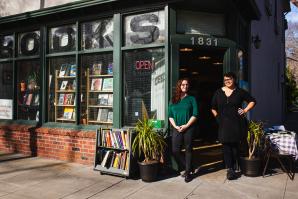
Getting to Know: Miranda Culp and Laurelin Gilmore
The owners of Amatoria Fine Art Books in Sacramento share a deep love of books
Miranda Culp and Laurelin Gilmore are accustomed to the look of
wonder on the faces of the people who stumble into their
independent bookshop, Amatoria Fine Art Books.
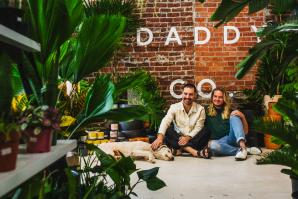
Getting to Know: Jacob Dill
Co-owner of Plant Daddy Co. in East Sacramento says retail business is booming
Luke Swanson and Jacob Dill, cofounders of Plant Daddy Co., are partners in life and business and discovered the joy of plant parenthood in their 20s living in San Francisco and Portland.
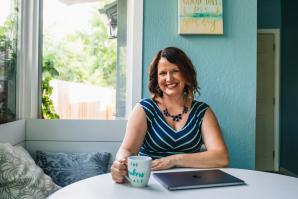
Getting to Know: Leslie Bosserman
Founder of The Makers Place builds a support system for working parents
Longing for a way to be creative during the hours she felt most energized, Bosserman set out to develop a community space for working families in early 2018.
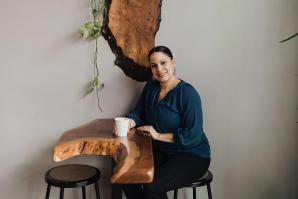
Getting to Know: Anita Ross
Sacramento life coach promotes the power of self-love
Anita Ross is on a mission to coach women and equip them with the tools to live their dreams.



